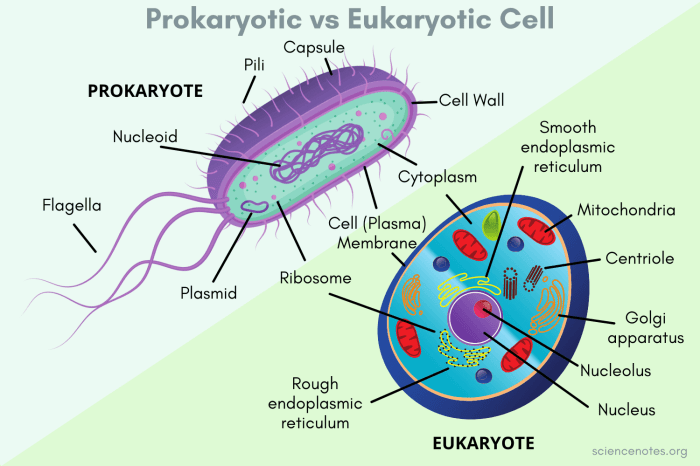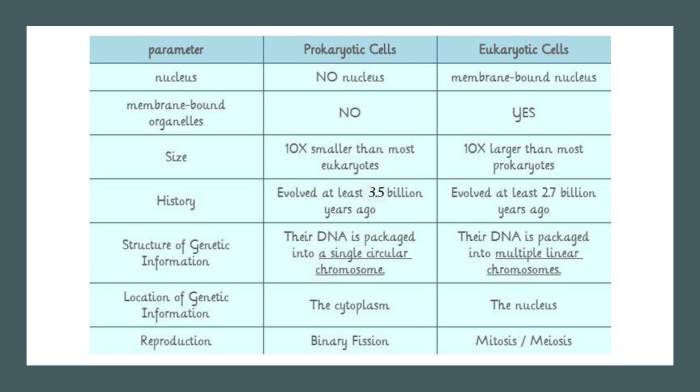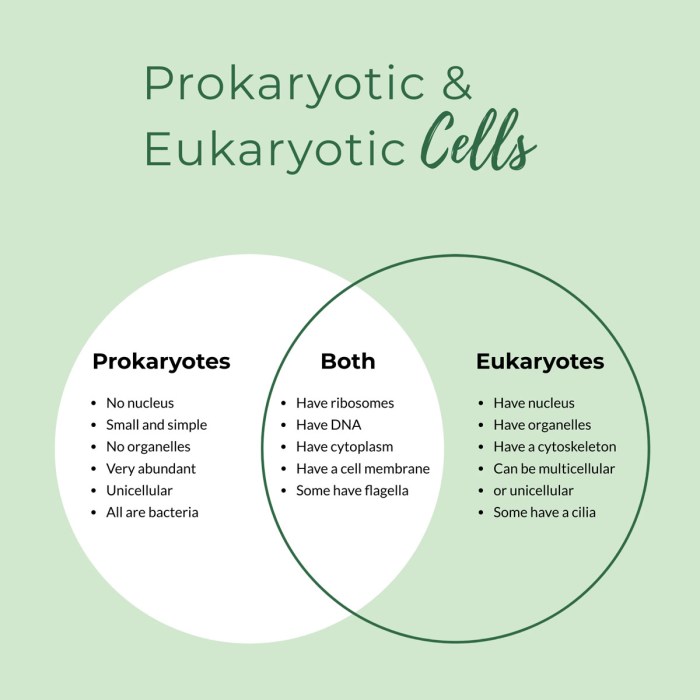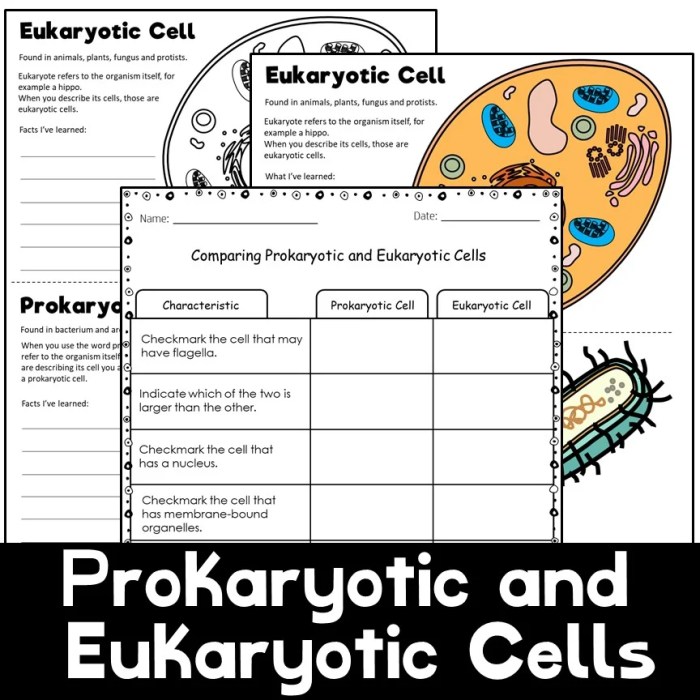Comparing prokaryotic and eukaryotic cells worksheet answers – Unveiling the intricacies of life’s building blocks, this exploration delves into the fascinating world of prokaryotic and eukaryotic cells, uncovering their distinct characteristics and fundamental roles in the tapestry of life.
Through a comprehensive analysis of their structural differences, genetic material, organelles, and cell division processes, we embark on a journey to decipher the complexities that set these two cellular realms apart.
Introduction

Cells are the basic unit of life, and they come in two main types: prokaryotic and eukaryotic. Prokaryotic cells are simpler and smaller than eukaryotic cells, and they lack a nucleus or other membrane-bound organelles. Eukaryotic cells, on the other hand, have a nucleus and other membrane-bound organelles, and they are typically larger and more complex than prokaryotic cells.
Understanding the differences between prokaryotic and eukaryotic cells is important for a number of reasons. First, it helps us to understand the evolution of life on Earth. Prokaryotic cells are the oldest type of cells, and they are thought to have given rise to eukaryotic cells.
Second, understanding the differences between prokaryotic and eukaryotic cells helps us to understand how different types of organisms function. Prokaryotic cells are found in bacteria and archaea, while eukaryotic cells are found in all other organisms, including plants, animals, and fungi.
Structural Differences

Cell Size
Prokaryotic cells are typically much smaller than eukaryotic cells. Prokaryotic cells typically range in size from 0.1 to 5 micrometers (µm), while eukaryotic cells typically range in size from 10 to 100 µm. The largest prokaryotic cells are about the same size as the smallest eukaryotic cells.
Cell Shape
Prokaryotic cells can have a variety of shapes, including spherical, rod-shaped, and spiral-shaped. Eukaryotic cells also have a variety of shapes, but they are typically more complex than prokaryotic cells. Eukaryotic cells can be flat, cube-shaped, or even star-shaped.
Cell Wall
Prokaryotic cells have a cell wall, while eukaryotic cells do not. The cell wall is a rigid structure that surrounds the cell membrane and helps to protect the cell from its surroundings. The cell wall is made of a variety of materials, including peptidoglycan, which is a complex carbohydrate.
Cell Membrane
Both prokaryotic and eukaryotic cells have a cell membrane. The cell membrane is a thin, flexible layer that surrounds the cell and controls the movement of materials into and out of the cell. The cell membrane is made of a phospholipid bilayer, which is a double layer of phospholipids.
Cytoplasm
The cytoplasm is the jelly-like substance that fills the cell. The cytoplasm contains all of the cell’s organelles, which are small structures that perform specific functions within the cell. The cytoplasm is also the site of many chemical reactions that are essential for the cell’s survival.
Ribosomes
Ribosomes are small organelles that are found in both prokaryotic and eukaryotic cells. Ribosomes are responsible for protein synthesis. Prokaryotic ribosomes are smaller than eukaryotic ribosomes, and they have a different structure.
Genetic Material

DNA, Comparing prokaryotic and eukaryotic cells worksheet answers
DNA is the genetic material of cells. DNA is a long, thin molecule that contains the instructions for making all of the proteins that the cell needs. In prokaryotic cells, DNA is typically found in a single, circular chromosome. In eukaryotic cells, DNA is typically found in multiple, linear chromosomes.
Chromosomes
Chromosomes are structures that organize DNA. Chromosomes are made up of DNA and proteins. Prokaryotic cells do not have chromosomes. Eukaryotic cells have chromosomes, and the chromosomes are located in the nucleus.
Plasmid
Plasmids are small, circular pieces of DNA that are found in some prokaryotic cells. Plasmids are not essential for the cell’s survival, but they can provide the cell with additional genes that can be beneficial. For example, some plasmids can confer antibiotic resistance to the cell.
Organelles: Comparing Prokaryotic And Eukaryotic Cells Worksheet Answers

Nucleus
The nucleus is a membrane-bound organelle that is found in eukaryotic cells. The nucleus contains the cell’s DNA. The nucleus is the control center of the cell, and it regulates all of the cell’s activities.
Endoplasmic Reticulum
The endoplasmic reticulum (ER) is a network of membranes that is found in eukaryotic cells. The ER is responsible for protein synthesis and lipid metabolism. There are two types of ER: rough ER and smooth ER. Rough ER has ribosomes attached to its surface, while smooth ER does not.
Golgi Apparatus
The Golgi apparatus is a membrane-bound organelle that is found in eukaryotic cells. The Golgi apparatus is responsible for modifying, sorting, and packaging proteins and lipids. The Golgi apparatus is also responsible for the formation of lysosomes.
Mitochondria
Mitochondria are membrane-bound organelles that are found in eukaryotic cells. Mitochondria are responsible for cellular respiration, which is the process of converting food into energy. Mitochondria have their own DNA, and they are thought to have evolved from bacteria.
Chloroplasts
Chloroplasts are membrane-bound organelles that are found in plant cells. Chloroplasts are responsible for photosynthesis, which is the process of converting sunlight into energy. Chloroplasts have their own DNA, and they are thought to have evolved from cyanobacteria.
Cell Division
Binary Fission
Binary fission is the process of cell division that occurs in prokaryotic cells. Binary fission is a simple process that results in the formation of two identical daughter cells. Binary fission begins with the replication of the cell’s DNA. The two copies of DNA then move to opposite ends of the cell, and the cell membrane pinches in the middle, dividing the cell into two daughter cells.
Mitosis
Mitosis is the process of cell division that occurs in eukaryotic cells. Mitosis is a more complex process than binary fission, and it results in the formation of two identical daughter cells. Mitosis begins with the replication of the cell’s DNA.
The two copies of DNA then move to opposite ends of the cell, and the nuclear membrane breaks down. The chromosomes then line up in the center of the cell, and the spindle fibers attach to the chromosomes. The spindle fibers then pull the chromosomes apart, and the cell membrane pinches in the middle, dividing the cell into two daughter cells.
Meiosis
Meiosis is a specialized type of cell division that occurs in eukaryotic cells. Meiosis is responsible for the production of gametes, which are the sex cells. Meiosis is a complex process that results in the formation of four daughter cells, each of which has half the number of chromosomes as the parent cell.
Meiosis begins with the replication of the cell’s DNA. The two copies of DNA then move to opposite ends of the cell, and the nuclear membrane breaks down. The chromosomes then line up in the center of the cell, and the spindle fibers attach to the chromosomes.
The spindle fibers then pull the chromosomes apart, and the cell membrane pinches in the middle, dividing the cell into two daughter cells. The two daughter cells then undergo a second round of cell division, resulting in the formation of four daughter cells, each of which has half the number of chromosomes as the parent cell.
Questions Often Asked
What is the primary difference between prokaryotic and eukaryotic cells?
The presence of a nucleus and membrane-bound organelles distinguishes eukaryotic cells from prokaryotic cells, which lack these structures.
Which type of cell is generally larger, prokaryotic or eukaryotic?
Eukaryotic cells are typically larger than prokaryotic cells, with a size range of 10-100 micrometers compared to 0.1-5 micrometers for prokaryotic cells.
What is the function of the cell wall in prokaryotic cells?
The cell wall in prokaryotic cells provides structural support, protection against osmotic pressure, and serves as a barrier against foreign substances.